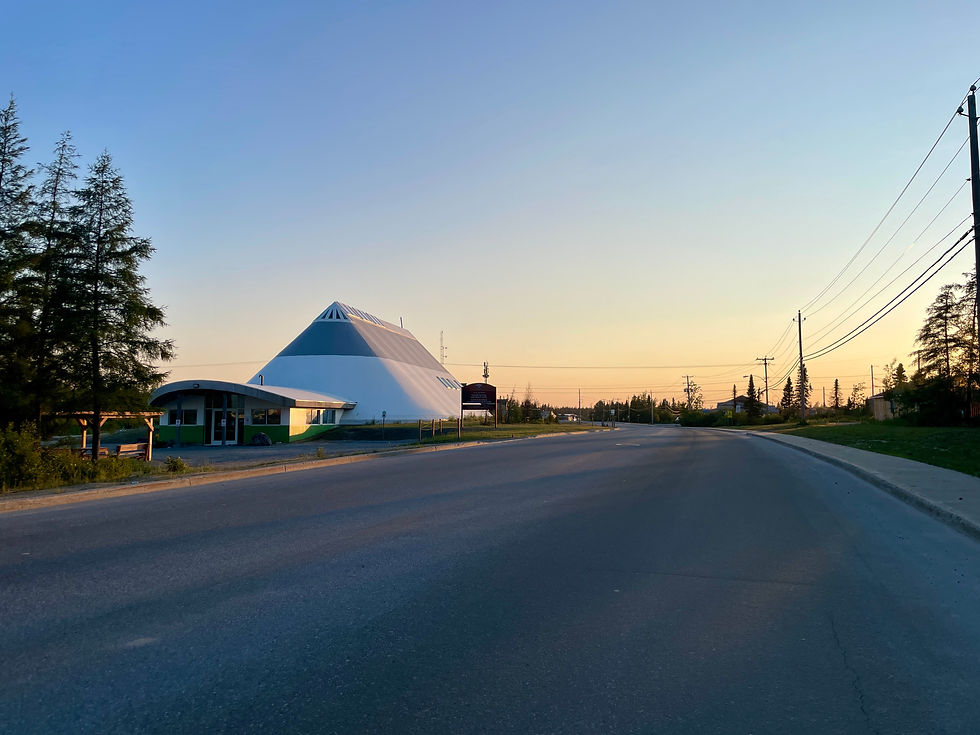Exploring the richness of Kuujjuarapik / Whapmagoostui
- Michelle Kwok

- Feb 28, 2024
- 4 min read
Updated: Jan 7

After a brief stop in the city for a week, I embarked on another journey to Nunavik, this time toward the west side of the Hudson Bay. Our airplane made a refuelling stop at Aéroport La Grande Rivière, a small strip near Radisson, Quebec, before reaching our destination. As I glanced out of the window at the vast expanse of snow-covered coniferous trees, I felt the burdens of urban life gradually fading away. The untouched beauty of the land seemed to offer a sense of peace amidst the complications of city life. In that serene moment, I couldn't help but feel the deep reverence that the Indigenous peoples have held to the land throughout millennia.
Whapmagoostui ᐙᐱᒫᑯᔥᑐᐃ, meaning "Place of the Beluga" in Cree, is the northernmost Cree community. Kuujjuarapik ᑰᔾᔪᐊᕌᐱᒃ means "Little Great River" and is the southernmost Inuit community. This twin town is the only area in Nunavik where Inuit and Cree live side by side. Access is limited to air travel and, during the summer months, by sea when the waters thaw. For simplicity purposes, I will refer to this twin town as the common name of "Great Whale" for its location up the Great Whale River.
This is my second visit to Great Whale. Last year, I had the privilege of taking a tour with Marianne Martin, the director of Minnies Hope Social Pediatric Centre. This unique clinic provides culturally appropriate and whole person-centered care towards more than 300 Inuit and Cree children, in a nurturing environment described as "Grandma's living room." Originally from Ontario, Marianne and her husband Rev. Tom Martin, embarked on what they believed would be a temporary posting in Great Whale in the 1980s. However, the communities captured their hearts, leading them to stay indefinitely. Today their children and now their grandchildren grow up in the same tight-knit community that has become their home.
Some attractions include:
The inukshuk, which offers a stunning view of the sunset over the Hudson Bay. Thanks to Caroline, a local resident, I had the opportunity to experience a ride on a skidoo to get a closer look at this iconic landmark.
St. Edmond’s Anglican church. The original structure was built in the 1880s using materials shipped from England and transported by dogsled by Inuit and Cree working together to its present location. Today, the new church accommodates larger congregations, especially during ceremonies like funerals and weddings. While I wasn’t able to explore the interior that day, I learned that the original church now serves as a historical museum showcasing cultural artifacts.
The community freezer, where beneficiaries can obtain meat from hunts, such as caribou, ensuring access to traditional foods.
Some intriguing aspects of life in Great Whale:
Petrol is brought by barge once a year during the summer, and the price is fixed based on the cost at the time of purchase in Montreal. Vehicles are similarly shipped up by barge.
Instead of passing a driving test, locals visit the clinic for a clean bill of health in order to obtain a "territorial license." This explained some of the "interesting" driving I witnessed, and speed is limited by snow and ice in winter. Additionally, wearing a seatbelt would get you teased as a southerner!
The distinct styles of buildings between the Inuit and Cree communities, reflecting differences in governance. Each side maintains its own public services, including fire halls, police departments, schools, and community centers. Interestingly, emergency calls differ between the two sides, with 9110 being the number to call for emergencies on the Inuit side (dialing 911 will not get you anywhere!)
Life in the transit and clinic
I had the privilege of working with an amazing team during my time in Great Whale. They were hardworking, enthusiastic, resourceful, and incredibly helpful and accommodating. The proactive head nurse Lysanne generously prepared the conference room for my clinic with everything I could possibly need.
I saw many new patients that were predominant pediatric cases. Additionally, I conducted follow-ups with patients I had seen the previous year, as well as individuals who had been seen down south. The patient list often changed rapidly, resembling a walk-in clinic scenario, leaving me with little time to prepare beforehand.
Despite the short notice, I remained flexible to tackle whatever came my way. It was not uncommon for a new consultation to include an evaluation, followed by skin testing, direct challenges, and delabeling—all within a single session. The patients were similarly adaptable, often staying for the entire morning or afternoon to complete the full consultation, despite not knowing beforehand what to expect.
One unexpected glitch arose when our transit lacked hot running water, which would have been a minor inconvenience under normal circumstances but challenging in the -30°C weather. Despite daily efforts to resolve the issue, it persisted until Thursday when Robert personally investigated and discovered a frozen pipe. He was able to restore the supply of hot water, treating us to the most luxurious shower in days. Though initially assuming the role of a maintenance man, it turned out that Robert Wynne was the local director of the Whapmagoostui Community Miyupimaatisiiun Centre. He proved to be extremely knowledgeable about the community while remaining humble as a leader.
There are other locals who went out of their way to make me feel welcome in Great Whale. Justin Jones, for example, ran all kinds of errands and made sure we made our flights safely! I know it won't be the last time I am visiting and I hope that others can also experience the richness that this community has to offer.






























So heartwarming to read about your work, helping indigenous peoples. Thank you for what you do!
I love your posts. Thanks for sharing these insights and cherished community experiences.